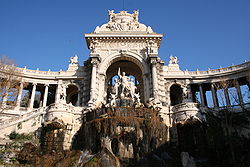
Parc Longchamp
Encyclopedia

Marseille
Marseille , known in antiquity as Massalia , is the second largest city in France, after Paris, with a population of 852,395 within its administrative limits on a land area of . The urban area of Marseille extends beyond the city limits with a population of over 1,420,000 on an area of...
: It houses the city's museum of fine arts and natural history museum. The surrounding park (the Parc Longchamp) is listed by the French Ministry of Culture as one of the Notable Gardens of France
Notable gardens of France
The Remarkable Gardens of France is intended to be a list and description, by region, of the over two hundred gardens classified as "Jardins remarquables" by the French Ministry of Culture and the Comité des Parcs et Jardins de France...
.
History
The Palais Longchamp was originally created to celebrate the construction of the Canal de MarseilleCanal de Marseille
The Canal de Marseille is a major source of drinking water for the city of Marseille, the largest city in Provence, France. The canal's length along its main artery is - though there is an additional of minor arteries - and it services the entire district of Marseille...
, which was built to bring water from the Durance River to Marseille. Although the foundation stone was laid by the Duke of Orleans on 15 November 1839, the building took 30 years to complete, partly because of the enormous expense and partly because of difficulties with local regulations. Designed by the architect Henry Esperandieu, the building was centered on the structure and elaborate fountain known as the chateau d'eau ("water castle").
Description

- The chateau d'eau
- The east wing, which houses the Musée des Beaux-Arts
- The west wing, which houses the Museum d'Histoire NaturelleMuséum d’histoire naturelle de MarseilleThe Muséum d’histoire naturelle de Marseille or Natural History Museum of Marseille was founded in 1819 by Jean-Baptiste, marquis de Montgrand...
The park
Parc Longchamp was opened in 1869, at the same time as the palace; in addition, the art and natural-history collections, which had previously been housed elsewhere, moved into the palace at this time. The park also contained a zoo, which was run by the city from 1898 until 1987, when, because of public disaffection with traditional zoos, it was closed.At the summit of the fountain are sculptures of four large bulls and three women—a central figure representing the Durance flanked by one who represents grapes/vines and one who represents wheat/fertility. Behind the women, within the central structure of the palace, is a manmade stone grotto decorated with carved stalactites and nymphs. From beneath the three women and from the bulls, water flows into a secondary basin, and then into an artificial pond. The water drains out of the pond into underground pipes, from which it emerges in a waterfall-like structure, and in twelve ornate bronze fountains lined alongside it, flowing into a second, larger pond.
The central feature of the garden behind the palace is a classic garden à la française
Garden à la française
The French formal garden, also called jardin à la française, is a style of garden based on symmetry and the principle of imposing order over nature. It reached its apogee in the 17th century with the creation of the Gardens of Versailles, designed for Louis XIV by the landscape architect André Le...
, which is known as the Jardin du plateau. The garden also includes an English landscape garden
English garden
The English garden, also called English landscape park , is a style of Landscape garden which emerged in England in the early 18th century, and spread across Europe, replacing the more formal, symmetrical Garden à la française of the 17th century as the principal gardening style of Europe. The...
, with winding alleys and many notable trees, including a 150-year-old plane tree and an oak
Oak
An oak is a tree or shrub in the genus Quercus , of which about 600 species exist. "Oak" may also appear in the names of species in related genera, notably Lithocarpus...
and a Siberian elm
Elm
Elms are deciduous and semi-deciduous trees comprising the genus Ulmus in the plant family Ulmaceae. The dozens of species are found in temperate and tropical-montane regions of North America and Eurasia, ranging southward into Indonesia. Elms are components of many kinds of natural forests...
that are both 120 years old.
The area that was occupied by the 19th-century zoo still contains many of its picturesque buildings in fantastic styles, including oriental pavilions for the giraffe
Giraffe
The giraffe is an African even-toed ungulate mammal, the tallest of all extant land-living animal species, and the largest ruminant...
and elephant
Elephant
Elephants are large land mammals in two extant genera of the family Elephantidae: Elephas and Loxodonta, with the third genus Mammuthus extinct...
, cages ornamented with Turkish tiles, and bear cages and seal dens decorated with rocaille, or rock-work.

